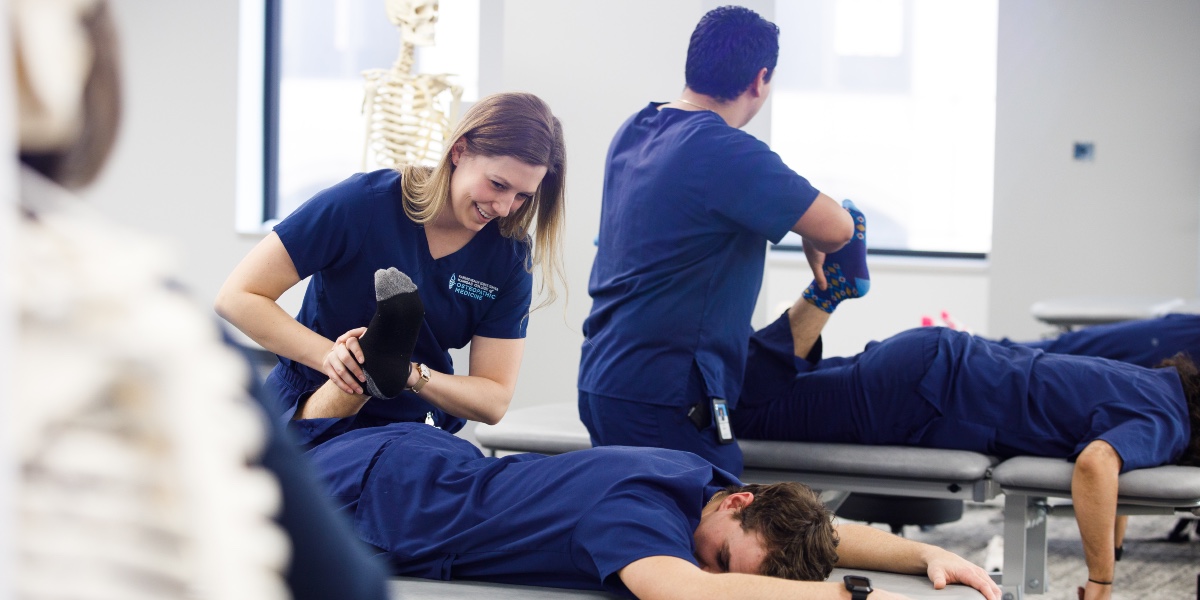Kansas College of Osteopathic Medicine offers a student-focused, patient-centered osteopathic program. In this program, students learn osteopathic manipulative treatment (OMT), which involves the muscle energy technique.
OMT is manual manipulation used to treat somatic dysfunction, improve motion and neuromuscular function, decrease pain, and improve biochemical balance. KansasCOM teaches OMT techniques to help treat health issues, aiding or replacing prescription drugs or invasive treatments such as surgery.
What is the Muscle Energy Technique?
The muscle energy technique (MET) is one of two methods of osteopathic manipulative treatment. MET is a direct approach, restricting the patient’s muscle movement through a counterforce while the patient contracts the muscle of concern. This helps determine the muscle strength and extent of muscle weakness or pain restriction. The muscle energy technique helps musculoskeletal dysfunction by decreasing the tone and allowing the muscle to develop more muscle length.
The muscle energy treatment uses intrinsic and extrinsic reflex systems to assist in the activation and relaxation of muscles, promoting stretching and healing.
Intrinsic Reflex System
The intrinsic reflex system includes the muscles that respond to changes in their length and tension. The myotatic unit-the muscle fibers and sensors that detect changes- is a key part of the intrinsic reflex system.
When the patient is experiencing somatic dysfunction, when a muscle is tight, the body will contract to reduce the tension on the nuclear fibers (which detects how much a muscle is stretching). When osteopathic doctors apply the muscle energy technique, the patient’s muscle will contract a muscle without changing its length, and the nuclear bag fibers adapt. Nuclear bag fibers detect current tension in the muscles and adapt slowly. These muscle fibers will help release the tension, reducing or eliminating tension-related pain or discomfort.
Extrinsic Reflex System
The extrinsic reflex system connects muscles to other parts of the body, signaling muscle from the brain, spinal cord, and nerves to help coordinate movement and protect the body from harm. There are three main types of extrinsic reflexes:
- Reciprocal Inhibition: Contracting one muscle so the opposite muscle relaxes
- Pain Avoidance Reflexes: Muscles adjusting to avoid further pain
- Viscerosomatic Reflexes: Internal organs signaling muscle tensions causing spasms.
All of the reflexes work together to balance and react to both internal and external changes. Osteopathic doctors learn to understand and manipulate these reflexes to assist in treating musculoskeletal issues.
Muscle Energy Technique Benefits
When osteopathic doctors use the muscle energy technique, it is with the intent to reduce or eliminate the need for painkillers, injections, or surgical procedures. It can be used to treat a variety of conditions, including:
- Headaches
- Arthritis
- Stress injuries
- Lower back pain
- Shoulder, neck, or knee pain
- Limited range of motion
- Trigger points
- Somatic dysfunction
- Shortened or spastic muscle
- Pelvic imbalance
MET is commonly used by osteopathic doctors, physical therapists, and chiropractors to treat pain caused by hypertonicity in the back, neck, or major joints. Using muscle energy simultaneously with standard care for conditions such as pneumonia and fibromyalgia can help improve lymphatic and hemodynamic function, improving outcomes.
How to Use MET
KansasCOM teaches our osteopathic students how to apply the muscle energy technique as part of the osteopathic manipulative treatment. As an example, here is how to treat a piriformis muscle (a muscle in the pelvis through the sciatic notch):
- Positioning the Patient: Have the patient lay on their back while the doctor stands on the side of the target piriformis muscle.
- Knee and Foot Placement: The patient should bend their knee on the affected piriformis side and move their foot to the outside of the opposite knee.
- Engage the Restrictive barrier: Gently push the bent knee towards the patient’s midline until you feel resistance (the restrictive barrier).
- Activate the Muscle Contraction: Ask the patient to push their against your hand for 3 to 5 seconds while applying mild resistance.
- Relax and Stretch the Muscle: Give the knee a small rest period, then gently push it into the newly extended range of motion.
Repeat the steps for three rounds, allowing you to meet a new resistance barrier each time. After completing the muscle energy technique, return the patient’s leg to a neutral position and reassess the piriformis.
Similar steps may apply to various muscle groups throughout the body, adjusting the patient for muscle contraction and creative and restrictive barriers to contracting muscle. Allowing the patient to relax and stretch between the manual manipulations enables the body to adjust and increase mobility while decreasing the potential for pain.
Do not use OMT or MET for fractures, torn ligaments or tendons, joint instability, infections, or on patients who recently underwent surgery.
Study The Muscle Energy Technique at KansasCOM
Apply to Kansas College of Osteopathic Medicine. As part of our osteopathic medicine program, we teach students the muscle energy technique (MET). The MET is just one part of the MET, which is an osteopathic manipulative treatment method used by osteopathic physicians.
The muscle energy technique can be used as a noninvasive and natural alternative to drugs and surgery for joint pain and tight muscles. It can also be used in conjunction with standard medical practices to increase patient outcomes. Start your journey to becoming a medical professional with specialized training in the musculoskeletal system as part of our osteopathic program.

